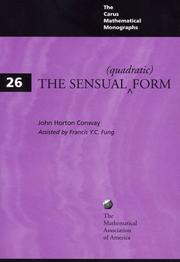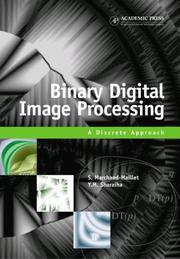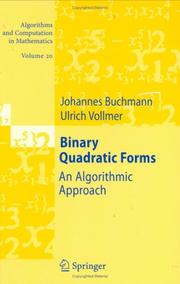| Listing 1 - 10 of 151 | << page >> |
Sort by
|
Book
ISBN: 1443868957 9781443868952 1322215928 9781322215921 144386126X 9781443861267 Year: 2014 Publisher: Newcastle upon Tyne, England : Cambridge Scholars Publishing,
Abstract | Keywords | Export | Availability | Bookmark
 Loading...
Loading...Choose an application
- Reference Manager
- EndNote
- RefWorks (Direct export to RefWorks)
Defining things through binary opposition - male/female, familiar/foreign, life/death - forms the base of human thinking. Adding moral assessment to logic, we often represent binaries even as divisions into good and evil. Exclusions based on the division of Us vs. Them make their presence felt during any conflict, and become crucial in times of war. However, binary thinking is inherent also in peaceful, everyday conversation, when politics, social issues, ethnicities and religious identities ...
Book
ISBN: 9811679649 9811679657 Year: 2022 Publisher: Singapore : Springer,
Abstract | Keywords | Export | Availability | Bookmark
 Loading...
Loading...Choose an application
- Reference Manager
- EndNote
- RefWorks (Direct export to RefWorks)

ISBN: 1614440255 9781614440253 0883850400 9780883850404 0883850303 9780883850305 9780883850312 0883850311 Year: 1999 Publisher: Washington (D.C.): Mathematical association of America,
Abstract | Keywords | Export | Availability | Bookmark
 Loading...
Loading...Choose an application
- Reference Manager
- EndNote
- RefWorks (Direct export to RefWorks)
Absolutely fascinating from beginning to end. Ian Stewart, New Scientist This is a book rich in ideas. They seem to burst forth from almost every page ... I suspect that the author's hope that 'even the experts will find some new enlightenment here' will be realized. The Mathematics Teacher A very original book ... The lectures are self-contained for the graduate reader ... full of new ideas, and thus of real interest also to experts. Zentralblatt für Mathematik John Horton Conway's unique approach to quadratic forms was the subject of the Hedrick Lectures given by him in August of 1991 at the Joint Meetings of the Mathematical Association of America and the American Mathematical Society in Orono, Maine. This book presents the substance of those lectures. The book should not be thought of as a serious textbook on the theory of quadratic forms - it consists rather of a number of essays on particular aspects of quadratic forms that have interested the author. The lectures are self-contained and will be accessible to the generally informed reader who has no particular background in quadratic form theory. The minor exceptions should not interrupt the flow of ideas. The Afterthoughts to the Lectures contain discussion of related matters that occasionally presuppose greater knowledge.
Forms, Quadratic. --- Quadratic forms --- Diophantine analysis --- Forms, Binary --- Number theory --- Harmonic analysis
Book
ISBN: 9780511576218 9780521493437 9780511508479 0511508476 0511576218 9780511504884 0511504888 0521493439 0511509138 051150702X Year: 2009 Publisher: Cambridge : Cambridge University Press,
Abstract | Keywords | Export | Availability | Bookmark
 Loading...
Loading...Choose an application
- Reference Manager
- EndNote
- RefWorks (Direct export to RefWorks)
Magnificent atlas of double and multiple stars for viewing with binoculars and telescopes: a must-have for stargazers.
Double stars --- Binaries (Stars) --- Binary stars --- Stars, Double --- Multiple stars --- Astronomy & Astrophysics --- Physical Sciences & Mathematics --- Astrophysics

ISBN: 0124705057 9780124705050 9780080527826 0080527825 1281059528 9781281059529 9786611059521 6611059520 Year: 2000 Publisher: San Diego, CA. ; London : Academic,
Abstract | Keywords | Export | Availability | Bookmark
 Loading...
Loading...Choose an application
- Reference Manager
- EndNote
- RefWorks (Direct export to RefWorks)
This book is aimed at faculty, postgraduate students and industry specialists. It is both a text reference and a textbook that reviews and analyses the research output in this field of binary image processing. It is aimed at both advanced researchers as well as educating the novice to this area. The theoretical part of this book includes the basic principles required for binary digital image analysis. The practical part which will take an algorithmic approach addresses problems which find applications beyond binary digital line image processing.The book first outlines the theoretical frame
Image processing --- Traitement d'images --- Digital techniques --- Mathematics --- Techniques numériques --- Mathématiques --- Binary system (Mathematics) --- Digital techniques. --- Binary system (Mathematics). --- Techniques numériques --- Mathématiques --- ELSEVIER-B EPUB-LIV-FT --- Digital image processing --- Digital electronics --- Mathematics.
Book
ISBN: 1281378569 9786611378561 3764386061 Year: 2008 Publisher: Basel ; Boston : Birkhauser,
Abstract | Keywords | Export | Availability | Bookmark
 Loading...
Loading...Choose an application
- Reference Manager
- EndNote
- RefWorks (Direct export to RefWorks)
After a classical presentation of quadratic mappings and Clifford algebras over arbitrary rings (commutative, associative, with unit), other topics involve more original methods: interior multiplications allow an effective treatment of deformations of Clifford algebras; the relations between automorphisms of quadratic forms and Clifford algebras are based on the concept of the Lipschitz monoid, from which several groups are derived; and the Cartan-Chevalley theory of hyperbolic spaces becomes much more general, precise and effective.
Clifford algebras. --- Forms, Quadratic. --- Quadratic forms --- Diophantine analysis --- Forms, Binary --- Number theory --- Geometric algebras --- Algebras, Linear --- Algebra. --- Mathematics --- Mathematical analysis
Book
ISBN: 1536118826 9781536118827 9781536118438 1536118435 Year: 2017 Publisher: New York : Nova Science Publishers,
Abstract | Keywords | Export | Availability | Bookmark
 Loading...
Loading...Choose an application
- Reference Manager
- EndNote
- RefWorks (Direct export to RefWorks)
Gender nonconformity --- Gender variance (Gender nonconformity) --- Genderqueer --- Non-binary gender --- TGNC (Transgender and gender nonconformity) --- Transgenderism --- Gender expression --- Gender identity
Book
Year: 2019 Publisher: Frontiers Media SA
Abstract | Keywords | Export | Availability | Bookmark
 Loading...
Loading...Choose an application
- Reference Manager
- EndNote
- RefWorks (Direct export to RefWorks)
This eBook is a collection of articles from a Frontiers Research Topic. Frontiers Research Topics are very popular trademarks of the Frontiers Journals Series: they are collections of at least ten articles, all centered on a particular subject. With their unique mix of varied contributions from Original Research to Review Articles, Frontiers Research Topics unify the most influential researchers, the latest key findings and historical advances in a hot research area! Find out more on how to host your own Frontiers Research Topic or contribute to one as an author by contacting the Frontiers Editorial Office: frontiersin.org/about/contact
Catalysis --- oxide-based materials --- surfaces --- Theory and experiments --- Ionic defects --- Density Functional Theory --- Binary oxides --- oxide perovskites

ISBN: 1280949252 9786610949250 3540463682 3540463674 3642079717 Year: 2007 Publisher: Berlin : Springer,
Abstract | Keywords | Export | Availability | Bookmark
 Loading...
Loading...Choose an application
- Reference Manager
- EndNote
- RefWorks (Direct export to RefWorks)
This book deals with algorithmic problems concerning binary quadratic forms 2 2 f(X,Y)= aX +bXY +cY with integer coe?cients a, b, c, the mathem- ical theories that permit the solution of these problems, and applications to cryptography. A considerable part of the theory is developed for forms with real coe?cients and it is shown that forms with integer coe?cients appear in a natural way. Much of the progress of number theory has been stimulated by the study of concrete computational problems. Deep theories were developed from the classic time of Euler and Gauss onwards to this day that made the solutions ofmanyof theseproblemspossible.Algorithmicsolutionsandtheirproperties became an object of study in their own right. Thisbookintertwinestheexpositionofoneveryclassicalstrandofnumber theory with the presentation and analysis of algorithms both classical and modern which solve its motivating problems. This algorithmic approach will lead the reader, we hope, not only to an understanding of theory and solution methods, but also to an appreciation of the e?ciency with which solutions can be reached. The computer age has led to a marked advancement of algorithmic - search. On the one hand, computers make it feasible to solve very hard pr- lems such as the solution of Pell equations with large coe?cients. On the other, the application of number theory in public-key cryptography increased the urgency for establishing the complexity of several computational pr- lems: many a computer system stays only secure as long as these problems remain intractable.
Forms, Binary. --- Forms, Quadratic. --- Quadratic forms --- Diophantine analysis --- Forms, Binary --- Number theory --- Binary forms --- Algebra. --- Number theory. --- Computer science. --- Data encryption (Computer science). --- Number Theory. --- Mathematics of Computing. --- Cryptology. --- Mathematics --- Mathematical analysis --- Data encoding (Computer science) --- Encryption of data (Computer science) --- Computer security --- Cryptography --- Informatics --- Science --- Number study --- Numbers, Theory of --- Algebra --- Computer science—Mathematics.
Book
ISSN: 16135237 ISBN: 1493901656 1461443245 1461443253 Year: 2012 Publisher: New York, NY : Springer New York : Imprint: Springer,
Abstract | Keywords | Export | Availability | Bookmark
 Loading...
Loading...Choose an application
- Reference Manager
- EndNote
- RefWorks (Direct export to RefWorks)
The study of combinatorial block designs is a vibrant area of combinatorial mathematics with connections to finite geometries, graph theory, coding theory and statistics. The practice of ordering combinatorial objects can trace its roots to bell ringing which originated in 17th century England, but only emerged as a significant modern research area with the work of F. Gray and N. de Bruijn. These two fascinating areas of mathematics are brought together for the first time in this book. It presents new terminology and concepts which unify existing and recent results from a wide variety of sources. In order to provide a complete introduction and survey, the book begins with background material on combinatorial block designs and combinatorial orderings, including Gray codes — the most common and well-studied combinatorial ordering concept — and universal cycles. The central chapter discusses how ordering concepts can be applied to block designs, with definitions from existing (configuration orderings) and new (Gray codes and universal cycles for designs) research. Two chapters are devoted to a survey of results in the field, including illustrative proofs and examples. The book concludes with a discussion of connections to a broad range of applications in computer science, engineering and statistics. This book will appeal to both graduate students and researchers. Each chapter contains worked examples and proofs, complete reference lists, exercises and a list of conjectures and open problems. Practitioners will also find the book appealing for its accessible, self-contained introduction to the mathematics behind the applications.
Block designs. --- Gray codes. --- Mathematics. --- Block designs --- Gray codes --- Mathematics --- Physical Sciences & Mathematics --- Algebra --- Mathematical Statistics --- Designs, Block --- Reflected binary codes --- Reflective binary codes --- Computer science --- Combinatorics. --- Mathematics, general. --- Discrete Mathematics in Computer Science. --- Binary system (Mathematics) --- Coding theory --- Combinatorial analysis --- Combinatorial designs and configurations --- Experimental design --- Computational complexity. --- Complexity, Computational --- Electronic data processing --- Machine theory --- Math --- Science --- Combinatorics --- Mathematical analysis --- Computer science—Mathematics.
| Listing 1 - 10 of 151 | << page >> |
Sort by
|

 Search
Search Feedback
Feedback About UniCat
About UniCat  Help
Help News
News